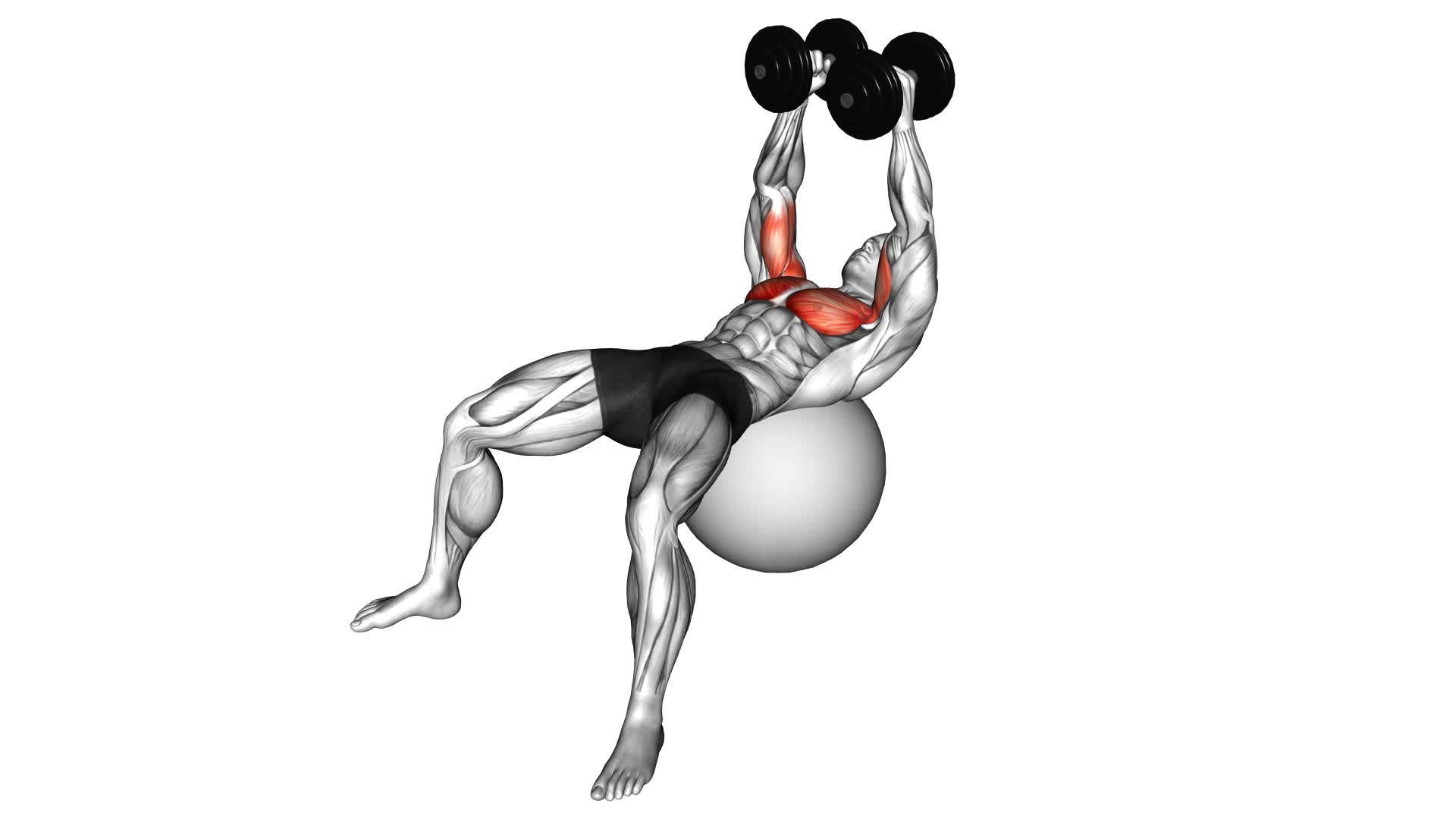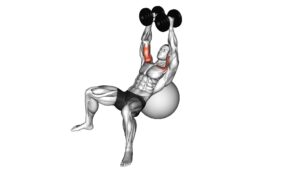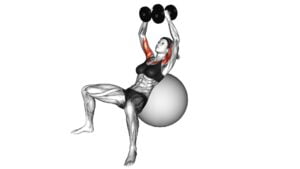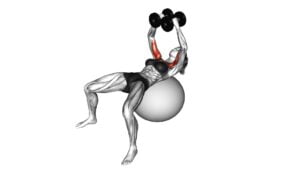Dumbbell Fly on Exercise Ball – Video Exercise Guide & Tips

Are you looking to take your workout to the next level?
Watch This Exercise Video
Then the Dumbbell Fly on an Exercise Ball is the perfect exercise for you.
This video exercise guide & tips will show you how to properly perform the move to maximize its benefits.
With just a few simple steps, you can strengthen your chest and shoulders while also improving your balance and stability.
Get ready to feel the burn and see amazing results with this challenging and effective exercise.
Key Takeaways
- The dumbbell fly on an exercise ball targets chest muscles, engages core and stabilizing muscles, increases overall effectiveness of the exercise, and enhances upper body strength.
- Proper form and technique for the dumbbell fly include lying on the exercise ball with head, neck, and upper back supported, holding dumbbells with palms facing each other and arms extended straight up, lowering dumbbells out to the sides with a slight bend in elbows, engaging chest muscles to bring dumbbells back up, and starting with lighter weights and gradually increasing as strength improves.
- Equipment needed for the dumbbell fly on an exercise ball includes an exercise ball for an unstable surface, dumbbells for resistance, and an exercise mat for cushioning and support. Using an exercise ball provides a greater range of motion and targets core muscles for added strength and stability.
- The exercise ball itself has benefits such as forcing muscles to work harder for balance and control, strengthening core muscles (including abs, back, and hips), improving overall stability and balance, enhancing proprioception and body control, and being beneficial for various activities and sports.
Benefits of the Dumbbell Fly on an Exercise Ball
You can strengthen your chest muscles and improve stability by performing the Dumbbell Fly on an Exercise Ball. This exercise specifically targets your chest muscles, helping to build strength and definition in that area. By using an exercise ball, you add an element of instability, which forces your chest muscles to work harder to maintain balance and control. This increases the overall effectiveness of the exercise, as it not only targets your chest muscles but also engages your core and other stabilizing muscles.
The Dumbbell Fly on an Exercise Ball is a compound exercise that involves the movement of your arms, bringing the dumbbells out to the sides and then back to the starting position. This motion not only targets your chest muscles but also engages your shoulders and upper back. By using dumbbells instead of a machine, you have more freedom of movement, allowing for a greater range of motion and a more effective workout.
Incorporating the Dumbbell Fly on an Exercise Ball into your workout routine can help you improve your chest strength and stability. By consistently performing this exercise, you can develop a stronger, more defined chest and enhance your overall upper body strength.
Proper Form and Technique for the Dumbbell Fly
To perform the Dumbbell Fly with proper form and technique, focus on maintaining a stable position on the exercise ball while bringing the dumbbells out to the sides and back to the starting position. Here are some key points to keep in mind for the proper technique of the Dumbbell Fly:
- Start by lying on an exercise ball with your head, neck, and upper back supported on the ball. Keep your feet flat on the ground and your knees at a 90-degree angle.
- Hold a dumbbell in each hand with your palms facing each other and your arms extended straight up above your chest.
- Slowly lower the dumbbells out to the sides, keeping a slight bend in your elbows. Stop when your arms are parallel to the ground or slightly lower.
- Pause for a moment and then engage your chest muscles to bring the dumbbells back up to the starting position, squeezing your chest at the top of the movement.
Proper form and technique for the Dumbbell Fly not only help you maximize the benefits of this exercise but also reduce the risk of injury. By focusing on maintaining stability on the exercise ball and performing controlled movements, you can effectively target and strengthen your chest muscles. Remember to start with lighter weights and gradually increase as your strength and stability improve.
Equipment Needed for the Dumbbell Fly on an Exercise Ball
To perform the dumbbell fly on an exercise ball, you'll need a pair of dumbbells and an exercise ball.
The exercise ball provides an unstable surface, which engages more muscles and helps improve balance and stability.
Using an exercise ball for the dumbbell fly also allows for a greater range of motion and targets the core muscles for added strength and stability.
Necessary Equipment for Dumbbell Fly
To perform the Dumbbell Fly on an Exercise Ball, you'll need the following equipment:
- Exercise Ball: The exercise ball provides an unstable surface, forcing your muscles to work harder to stabilize your body during the exercise. This helps improve balance and core strength.
- Dumbbells: Dumbbells are essential for the dumbbell fly variations. They allow you to work your chest muscles effectively by providing resistance during the exercise.
- Exercise Mat: Having an exercise mat underneath the exercise ball provides cushioning and support for your body, making the exercise more comfortable and preventing any discomfort or strain.
Now that you know the necessary equipment for the Dumbbell Fly on an Exercise Ball, let's move on to the benefits of exercise ball training.
Benefits of Exercise Ball
What are the benefits of using an exercise ball for the Dumbbell Fly?
Incorporating exercise ball exercises into your workout routine offers several advantages, particularly when it comes to stability training.
The unstable surface of the exercise ball forces your muscles to work harder to maintain balance and control throughout the exercise. This helps to strengthen your core muscles, including your abs, back, and hips.
By engaging these core muscles, you can improve your overall stability and balance, which can be beneficial for various activities and sports.
Additionally, using an exercise ball can also help to enhance your proprioception, which is your body's awareness of its position in space.
This heightened sense of proprioception can improve your coordination and body control.
Common Mistakes to Avoid During the Dumbbell Fly
To perform the dumbbell fly correctly, it's important to avoid a few common mistakes.
First, make sure your arm positioning is correct by keeping a slight bend in your elbows throughout the exercise.
Secondly, avoid overarching your back, as this can put unnecessary strain on your lower back.
Lastly, be mindful of using excessive weight, as this can compromise your form and increase the risk of injury.
Incorrect Arm Positioning
Avoid positioning your arms incorrectly during the dumbbell fly exercise to maximize effectiveness and prevent injury. Here are some common mistakes to avoid:
- Elbows too straight: Keeping your elbows completely straight puts unnecessary strain on your joints and can lead to injury. Make sure to maintain a slight bend in your elbows throughout the exercise.
- Arms too far apart: If your arms are positioned too wide, you won't be targeting the intended muscles effectively. Keep your arms at a comfortable distance apart, slightly wider than shoulder-width.
- Arms too close together: Conversely, if your arms are positioned too close together, you won't be able to fully engage your chest muscles. Keep a moderate distance between your arms to ensure proper muscle activation.
Overarching the Back
To avoid overarching your back during the dumbbell fly exercise, make sure you maintain proper posture and engage your core muscles. Overarching the back refers to excessive arching or hyperextension of the spine, which can lead to strain and injury. It's a common mistake that many people make during this exercise.
By overarching, you put excessive stress on your lower back, which can lead to discomfort and potential long-term issues. It's important to note that there are no benefits to overarching the back during the dumbbell fly exercise.
To avoid this mistake, focus on maintaining a neutral spine and engaging your core muscles to provide stability and support. This will help you perform the exercise correctly and reduce the risk of injury.
Using Excessive Weight
When performing the dumbbell fly exercise, be cautious of using excessive weight. Using improper form and attempting to lift more weight than you can handle can lead to potential injuries. It's important to remember that the dumbbell fly is a controlled movement that focuses on strengthening the chest muscles and shouldn't be treated as a competition to see how much weight you can lift.
To avoid injuries and ensure proper form, here are some key points to keep in mind:
- Start with lighter weights and gradually increase the weight as you become more comfortable with the exercise.
- Focus on maintaining a slow and controlled movement throughout the exercise.
- Keep your elbows slightly bent and avoid locking them out to prevent strain on the joints.
By using the proper weight and maintaining proper form, you can minimize the risk of injuries and maximize the benefits of the dumbbell fly exercise.
Now, let's explore some variations and modifications of the dumbbell fly on an exercise ball.
Variations and Modifications of the Dumbbell Fly on an Exercise Ball
Try incorporating different variations and modifications into your dumbbell fly on an exercise ball routine to enhance your workout. Adding variations to your routine not only keeps it interesting but also targets different muscle groups, providing a more well-rounded workout.
One variation you can try is the incline dumbbell fly on an exercise ball. This variation increases the challenge by targeting the upper chest muscles. To perform this variation, adjust the angle of the exercise ball to create an incline and then perform the dumbbell fly as usual.
Another modification you can make is to perform the exercise with one arm at a time. This unilateral variation helps to improve balance and stability while also allowing you to focus on each side of your chest individually.
Additionally, you can experiment with different grip variations, such as using a neutral grip or a pronated grip, to target different areas of your chest.
By incorporating these variations and modifications, you can keep your workouts fresh and continue to challenge your muscles.
Now, let's move on to some tips for getting the most out of the dumbbell fly on an exercise ball.
Tips for Getting the Most Out of the Dumbbell Fly on an Exercise Ball
To maximize your results from the dumbbell fly on an exercise ball, focus on maintaining proper form and engaging your chest muscles throughout the entire range of motion. This exercise is highly effective for building and toning your chest muscles, and using an exercise ball adds an extra level of challenge and instability, which engages your core muscles as well.
Here are some tips to help you get the most out of the dumbbell fly on an exercise ball:
- Keep your back flat on the ball and your feet firmly planted on the ground for stability.
- Start with lighter weights and gradually increase the resistance as you become more comfortable with the exercise.
- Control the movement and avoid using momentum to lift the dumbbells. This ensures that your chest muscles are doing the work and prevents strain on other muscle groups.
By following these tips, you won't only reap the benefits of the exercise ball, such as improved balance and stability, but also maintain proper dumbbell form, which is crucial for targeting and strengthening your chest muscles effectively.
Remember to always consult with a fitness professional before attempting any new exercises, especially if you have any pre-existing conditions or injuries.
Frequently Asked Questions
Can the Dumbbell Fly on an Exercise Ball Help With Improving Posture?
Yes, incorporating dumbbell fly on an exercise ball into your routine can help improve your posture.
By performing this exercise, you engage your core muscles, which are crucial for maintaining proper alignment and balance.
Additionally, the dumbbell fly targets your upper body, specifically the chest and shoulders, increasing upper body strength.
This improved strength and stability can contribute to better posture as you develop stronger muscles that support your spine and maintain an upright position.
Is It Necessary to Use an Exercise Ball for the Dumbbell Fly Exercise?
Using an exercise ball for the dumbbell fly exercise can be beneficial, especially if you're looking to improve balance. It adds an element of instability, which engages your core muscles and challenges your body to maintain stability.
However, it isn't necessary to use an exercise ball for this exercise. There are variations of the dumbbell fly that can be done on a flat bench or even on the floor.
Ultimately, it depends on your preference and fitness goals.
How Heavy Should the Dumbbells Be for Performing the Dumbbell Fly on an Exercise Ball?
To determine the appropriate dumbbell weight for the dumbbell fly on an exercise ball, consider your current strength and fitness level. Start with a weight that challenges you, but still allows you to maintain proper form throughout the exercise. Gradually increase the weight as you become stronger and more comfortable with the exercise.
Remember to focus on maintaining a stable core and controlled movement while performing the dumbbell fly on the exercise ball.
Can the Dumbbell Fly on an Exercise Ball Help With Strengthening the Core Muscles?
Yes, the dumbbell fly on an exercise ball can definitely help with strengthening your core muscles.
This exercise requires you to engage your core for balance and stability while performing the fly movement.
By doing so, you aren't only targeting your chest and shoulder muscles, but also working your abs, obliques, and lower back.
This exercise is a great way to add an extra challenge to your core workout routine.
Are There Any Precautions or Contraindications for Performing the Dumbbell Fly on an Exercise Ball?
When performing the dumbbell fly on an exercise ball, it's important to be aware of certain precautions and contraindications. These are essential for your safety and to prevent any injuries.
Make sure you have good balance and stability before attempting this exercise. If you have any existing back or shoulder issues, it's best to consult with a healthcare professional to determine if this exercise is suitable for you.
Always listen to your body and stop if you experience any pain or discomfort.
Conclusion
In conclusion, the dumbbell fly on an exercise ball is a beneficial exercise that targets the chest muscles while also engaging the core.
It's important to maintain proper form and technique to maximize the effectiveness of this exercise.
Avoid common mistakes and consider variations or modifications to challenge yourself further.
By following these tips, you can get the most out of your dumbbell fly on an exercise ball and achieve your fitness goals.

Author
Years ago, the spark of my life’s passion ignited in my mind the moment I stepped into the local gym for the first time. The inaugural bead of perspiration, the initial endeavor, the very first surge of endorphins, and a sense of pride that washed over me post-workout marked the beginning of my deep-seated interest in strength sports, fitness, and sports nutrition. This very curiosity blossomed rapidly into a profound fascination, propelling me to earn a Master’s degree in Physical Education from the Academy of Physical Education in Krakow, followed by a Sports Manager diploma from the Jagiellonian University. My journey of growth led me to gain more specialized qualifications, such as being a certified personal trainer with a focus on sports dietetics, a lifeguard, and an instructor for wellness and corrective gymnastics. Theoretical knowledge paired seamlessly with practical experience, reinforcing my belief that the transformation of individuals under my guidance was also a reflection of my personal growth. This belief holds true even today. Each day, I strive to push the boundaries and explore new realms. These realms gently elevate me to greater heights. The unique combination of passion for my field and the continuous quest for growth fuels my drive to break new ground.







